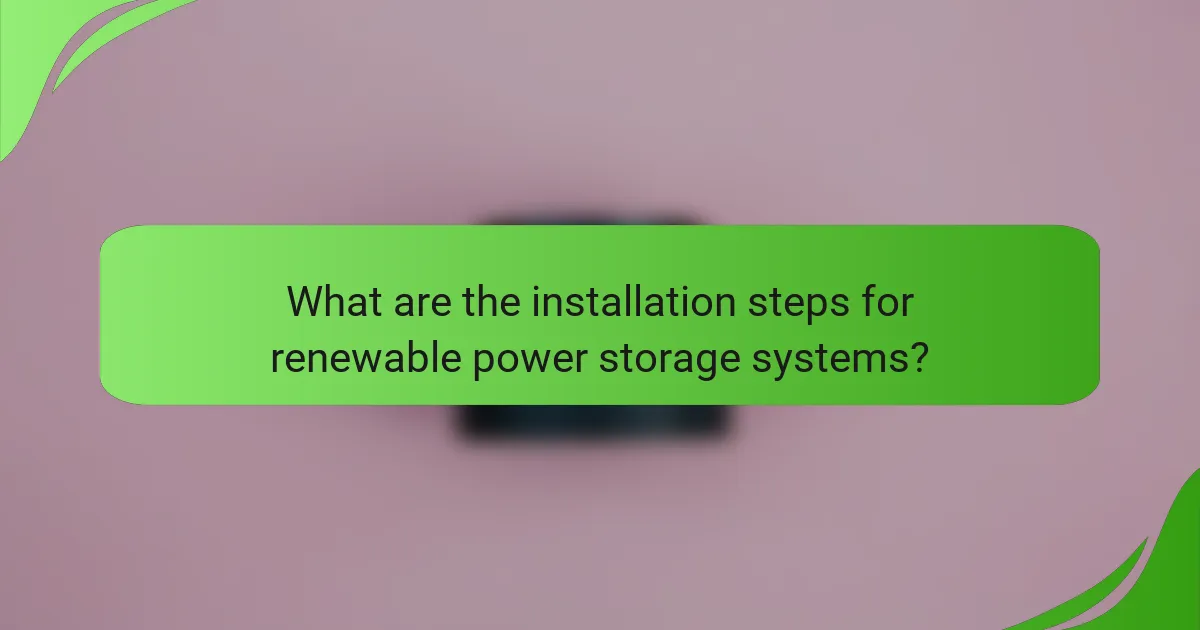The installation of renewable power storage systems is a multifaceted process that requires careful planning and execution to maximize efficiency and safety. Key steps include site assessment, battery selection, system design, component installation, and thorough integration testing. Additionally, implementing crucial safety checks throughout the process is vital to mitigate hazards and ensure compliance with standards. Utilizing the right tools is also essential for a successful and secure installation.

What are the installation steps for renewable power storage systems?
The installation of renewable power storage systems involves several critical steps to ensure efficiency and safety. These steps include assessing the site, selecting the appropriate battery, designing the system, installing components, and finally integrating and testing the system.
Site assessment and preparation
Begin by evaluating the installation site to determine its suitability for a renewable power storage system. Consider factors such as available space, proximity to power sources, and environmental conditions. Ensure that the location complies with local regulations and zoning laws.
Prepare the site by clearing any debris and ensuring a stable foundation for the storage system. This may involve leveling the ground or constructing a platform to support the weight of the batteries and other components.
Battery selection and procurement
Selecting the right battery is crucial for the performance of the storage system. Consider factors such as capacity, lifespan, efficiency, and cost. Common options include lithium-ion, lead-acid, and flow batteries, each with its own advantages and disadvantages.
Once you have determined the best battery type for your needs, procure the batteries from reputable suppliers. Ensure that the batteries meet relevant safety standards and are compatible with your overall system design.
System design and configuration
Design the system by determining how the batteries will be configured to meet your energy storage needs. This includes deciding on the number of batteries, their arrangement, and the integration of inverters and charge controllers. Use software tools or consult with professionals to optimize the design.
Consider future scalability in your design. This allows for potential expansion of the system as energy needs grow or technology advances, ensuring long-term viability.
Installation of components
Install the components according to the design specifications, starting with the battery system. Ensure that all electrical connections are secure and that the installation adheres to local electrical codes. Proper installation is critical to prevent safety hazards and ensure optimal performance.
Pay attention to ventilation and temperature control during installation, as batteries can generate heat. Adequate airflow helps maintain performance and prolongs battery life.
System integration and testing
Once all components are installed, integrate the system by connecting the batteries to the inverter and other electrical systems. This step ensures that the storage system can effectively manage energy flow between the renewable source and the grid or load.
Conduct thorough testing to verify that the system operates correctly. Check for proper charging and discharging cycles, monitor performance metrics, and ensure that safety features function as intended. Address any issues before the system goes live to ensure reliability and safety.

What safety checks are necessary during installation?
During the installation of renewable power storage systems, several safety checks are crucial to ensure both functionality and safety. These checks help identify potential hazards and ensure compliance with relevant standards, ultimately protecting both the installation team and the end-users.
Electrical safety inspections
Electrical safety inspections are vital to prevent electrical hazards during installation. Inspectors should verify that all wiring is correctly installed, connections are secure, and components meet local electrical codes. This includes checking for proper grounding and ensuring that circuit breakers and fuses are appropriately rated.
Common pitfalls include overlooking loose connections or using incompatible components. Always use a multimeter to test voltage levels and continuity before proceeding with the installation.
Structural integrity assessments
Assessing structural integrity is essential to ensure that the installation site can support the renewable power storage system. This involves checking the stability of mounting structures and ensuring that they can withstand environmental factors such as wind and weight loads. Engaging a structural engineer may be necessary for larger systems.
Look for signs of wear or damage in existing structures, such as cracks or corrosion. Regular inspections can help identify potential issues before they become critical.
Fire safety measures
Implementing fire safety measures is crucial when installing renewable power storage systems. This includes ensuring that all components are rated for fire resistance and that there are adequate fire suppression systems in place, such as extinguishers or sprinklers, especially in areas with high energy density.
Regularly review local fire codes and regulations to ensure compliance. Additionally, maintain clear access to fire safety equipment and establish an emergency response plan for potential fire incidents related to the storage system.

What tools are required for installation?
To successfully install renewable power storage systems, a variety of tools are essential. These tools ensure proper setup, safety, and functionality of the system.
Basic hand tools
Basic hand tools are fundamental for any installation task. Commonly required tools include screwdrivers, wrenches, pliers, and a hammer. These tools help in assembling components and securing connections effectively.
When selecting hand tools, consider the specific requirements of the storage system. For instance, a torque wrench may be necessary for ensuring that bolts are tightened to the manufacturer’s specifications.
Electrical testing equipment
Electrical testing equipment is crucial for verifying the integrity and safety of electrical connections. Multimeters, clamp meters, and insulation testers are commonly used to check voltage, current, and insulation resistance.
Using electrical testing equipment helps prevent potential hazards during and after installation. Ensure that the equipment is calibrated and suitable for the voltage levels of the renewable power storage system.
Safety gear and equipment
Safety gear and equipment are vital for protecting installers during the installation process. Essential items include safety goggles, gloves, hard hats, and insulated tools to prevent electrical shocks.
Before starting the installation, conduct a safety check to ensure all gear is in good condition. Following safety regulations and guidelines will minimize risks and enhance the overall safety of the installation environment.

How do local regulations affect installation?
Local regulations significantly influence the installation of renewable power storage systems by dictating necessary permits, compliance with building codes, and safety standards. Understanding these regulations is crucial to ensure a smooth installation process and avoid potential legal issues.
Permitting requirements
Before installing a renewable power storage system, obtaining the appropriate permits is essential. These permits vary by locality and can include zoning approvals, environmental assessments, and electrical permits. It’s advisable to check with local authorities or a qualified contractor to identify the specific permits needed for your project.
Failure to secure the necessary permits can lead to fines, delays, or even removal of the installed system. Always keep documentation of your permits on hand during the installation process to ensure compliance with local regulations.
Building codes compliance
Compliance with local building codes is critical when installing renewable power storage systems. Building codes ensure that installations meet safety and structural integrity standards. These codes can dictate aspects such as the placement of equipment, electrical connections, and fire safety measures.
To ensure compliance, review the local building codes relevant to your area and consult with professionals who are familiar with these regulations. Non-compliance can result in costly modifications or legal repercussions, so it’s wise to prioritize adherence to these codes throughout the installation process.

What are the best practices for maintaining renewable power storage systems?
Maintaining renewable power storage systems involves regular monitoring and specific maintenance procedures to ensure optimal performance and longevity. Implementing best practices can prevent costly failures and enhance efficiency.
Regular performance monitoring
Regular performance monitoring is crucial for identifying issues early and ensuring that renewable power storage systems operate efficiently. This includes tracking metrics such as charge and discharge cycles, temperature, and overall system efficiency.
Consider using monitoring software that provides real-time data and alerts for any anomalies. Schedule monthly or quarterly reviews to analyze performance trends and make necessary adjustments to optimize the system.
Battery maintenance procedures
Battery maintenance procedures are essential for extending the life of storage systems. This includes checking electrolyte levels in lead-acid batteries, ensuring terminals are clean and tight, and verifying that battery management systems are functioning correctly.
Implement a routine maintenance schedule, ideally every 3-6 months, to perform these checks. Avoid overcharging or deep discharging batteries, as these practices can significantly reduce their lifespan. Always follow manufacturer guidelines for specific maintenance tasks.
